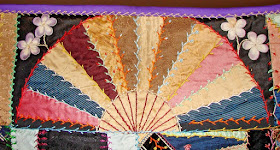Woman quilting in Woodville, California, 1942
Photo by Russell Lee for the W.P.A. Farm Security Administration.
During the Great Depression and into World War II the federal government
hired photographers to record rural life in hard times.
Family in Gees Bend
From California migrant camps to chronically poor Southern rural communities in Alabama, the photographers---most of them men---did a good job of recording women's activities.
Few names were recorded and little context given.
The seamstress is identified as Mrs. L. Smith,
Carroll County, Georgia.
Mother of a tenant farmer piecing a log cabin block,
Maricopa County, Arizona
Dorothea Lange was one woman who worked for the project.
Her photo of a "Migrant Mother" in California is an American icon,
capturing the pain and uncertainty of life as a displaced person.
Lange also photographed this woman and a man (perhaps her son or grandson)
quilting on a Chimney Sweep quilt in migrant housing in Kern County, California.
Another iconic image is Russell Lee's photo of a homeless woman quilting
in a smoke house in Hinesville, Georgia.
When I first saw these photos I was impressed by the role of quilting in people's lives and how women manage to keep this great folk art alive despite hardships. But I've since learned a few things. One is that the Corn & Beans quilt that the woman above is quilting in a fan pattern is cheater cloth, pre-printed yardage in a patchwork design.
Family quilting in Mississippi by Russell Lee in 1939
This fan design looks like pre-printed cloth too.
The other insight is that many of these women are part of the commercial aspect of quiltmaking. I bet many of them were sewing and quilting to earn money. This turns a lot of my own long-held basic assumptions about quiltmaking around. Folk art; schmoke art. Keeping up one's spirits during financial disasters? I don't think so. Raising money to feed the kids is more likely.
Grant County, Illinois, 1940
When you are as poor as these women seem to be
spending one's time making pretty things for the house seems like a luxury.
Marion Post Wolcott, Missouri migrants airing their bedding in a Florida campsite.
Coffee County, Alabama
By Marion Post Wolcott, a second female photographer.
Spring cleaning or advertising quilts for sale?
Carding surplus cotton for batting in Kern County, California.
Some of the quiltmakers do seem to be making quilts for their own bedding.
Green County, Georgia, 1940. Jack Delano photo.
Green County, Georgia
Particularly these tied whole cloth pieces.
Whole cloth quilt in Coffey County, Alabama
Mrs. L.L. LeCompt, Coffee County, Georgia, 1939
Marion Post Wolcott, photo.
But I'd certainly like to know more about the economics
in these quilting communities. These women are not sewing as a hobby.
Read more about my new take on my old assumptions regarding folk art versus commercial art in my blog Woman's Work: Making a Living Making Quilts.
Most of the photos above are from the Library of Congress's webpage on Farm Security Photographs. Here's a search for quilt:
http://www.loc.gov/pictures/search/?q=quilt&sp=3&co=fsa



















































